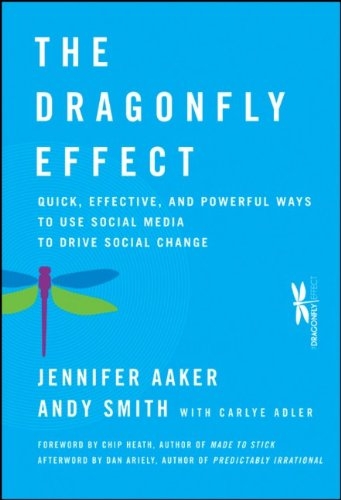
What can you do to transform the world through the social media? Is there a step-by-step way to drive social change?
In the words of former US President Barack Obama, “Yes We Can!” The answer lies in the Dragonfly Effect.
Co-authored by Stanford University Marketing Professor Jennifer Aaker and her husband Andy Smith, a leading marketing consultant of Vonavona Ventures, The Dragonfly Effect offers a recipe for social change leveraging on the power of social media.
Unlike many other books on social media which are strong on examples but weak on structure, the book proposed a systematic design thinking oriented process which anybody can follow.
Framework for Social Change
Tapping the diverse fields of social media, marketing strategy, and consumer psychology, Aaker and Smith pepper their central thesis with many interesting case studies.
These include micro-lending initiative Kiva, TOMS’s one-for-one shoe movement whereby the company will donate a shoe to underprivileged kids in return for a shoe bought, and of course Barack Obama’s presidential campaign.
The most memorable example was that of Team Sameer and Team Vinay, a heartfelt story of how friends belonging to the South Asian community in the United States came together to find suitable bone marrows to save their stricken friends’ lives. Through the power of citizen activism, grassroots networks and social media, the teams recruited 3,500 volunteers, achieved more than one million media impressions and garnered 150,000 visitors to their websites.
How The Dragonfly Effect Works
How does the Dragonfly Effect work?
Principally, there are four “wings” of the model: Focus, Grab Attention, Engage, and Take Action.
Mirroring the way a dragonfly uses all four wings to propel itself, these phases can be represented by the model below:

Courtesy of the Dragonfly Effect
Let us look at how each of these “wings” relate to one another.
Wing One – Focus
For Wing 1, Focus, the authors urge you to begin your quest by identifying a single, concrete and measurable goal. This should adopt the acronym HATCH, ie
- Humanistic – Focus only on who you want to help, and not anything else;
- Actionable – Tactical micro goals (low hanging fruits) that culminate in a long-term macro goal;
- Testable – Come up with clear metrics that help you to evaluate your progress and deadlines, and to celebrate small wins along the way;
- Clarity – Keep your goal clear to improve your odds of success while generating momentum; and
- Happiness – Ensure that your goals are meaningful to you or your audience.
Wing Two – Grab Attention
For Wing 2, Grab Attention, your aim is to translate your social intent into activities that can generate some buzz.
Here, the acronym PUVV is used instead, ie
- Personal – Create a personal hook with your audience;
- Unexpected – Pique the curiosity of your followers by using new information and reframing the familiar;
- Visual – Use the power of photos and videos, a definite must in the age of social media;
- Visceral – Trigger the senses: sight, sound, hearing, or taste, and hence unleash the emotions of others.
Wing Three – Engage
The next Wing, Engage, is the stage where you start to build a community. This involves embracing a TEAM acronym as follows:
- Tell a Story – Compelling, sticky stories to convey critical information;
- Empathise – As you engage, let your audience engage you, and create narratives that spark them to action;
- Authentic – True passion and sincerity can often be more influential and emotionally resonant than superficial pleas;
- Match the media – How and where you say something is as important as what’s being said. Align your message with the context. Remember that the media is the message.
Wing Four – Take Action
In the final wing, Take Action, its design principles are embodied in EFTO…
- Easy – Yes, making it easy for others will increase your chances of success. Don’t make them leap through hoops;
- Fun – Use elements of game play, competition, humour and rewards to make people “feel like kids” again. If it ain’t fun, nobody will do it;
- Tailored – Customise the programmes to unique individuals and groups with specific interests or skills for greater impact;
- Open – Provide your point of view and story, and allow people to act without having to ask for permission.
Conclusion
Overall, I found the book very instructive and useful, with a step-by-step approach that anybody wanting to create a social movement can do. The case studies cited dive into pretty specific and pragmatic details which one can emulate, and they also covered the unique properties of different social technologies like blogs, Facebook, Twitter, YouTube and others without belabouring the point.
Perhaps the most meaningul message I got from the book came from Al Gore, former vice president, who once said…
“If you want to go quickly, go alone. If you want to go far, go together.” – Al Gore
By staying focused and concentraing on small acts that drive big change, The Dragonfly Effect provides a useful guide for social activism in the Web 2.0 age.
This article was first published as Book Review: The Dragonfly Effect : Driving Social Change through Social Media by Jennifer Aaker and Andy Smith on Blogcritics.


Through the power of citizen activism, grassroots networks and social media.
Local SEO